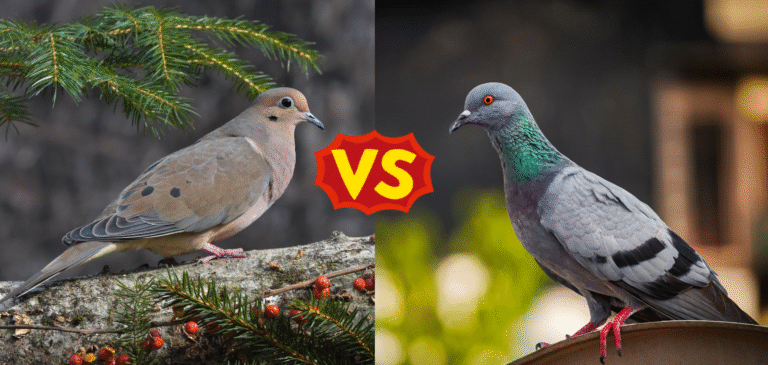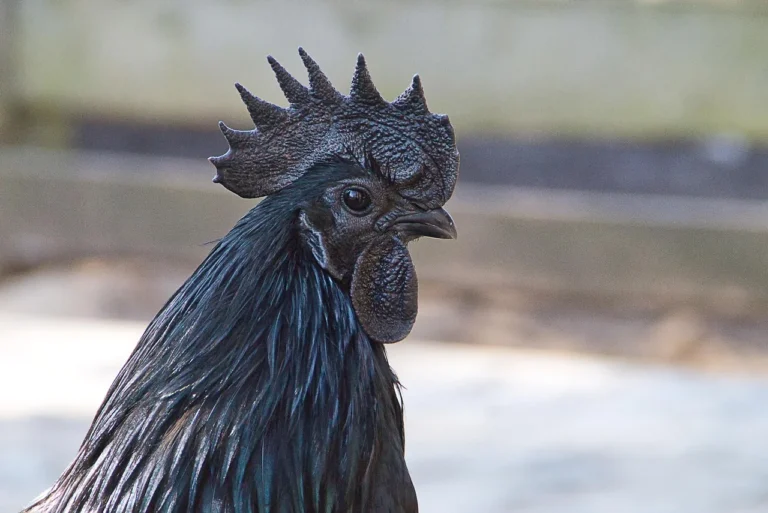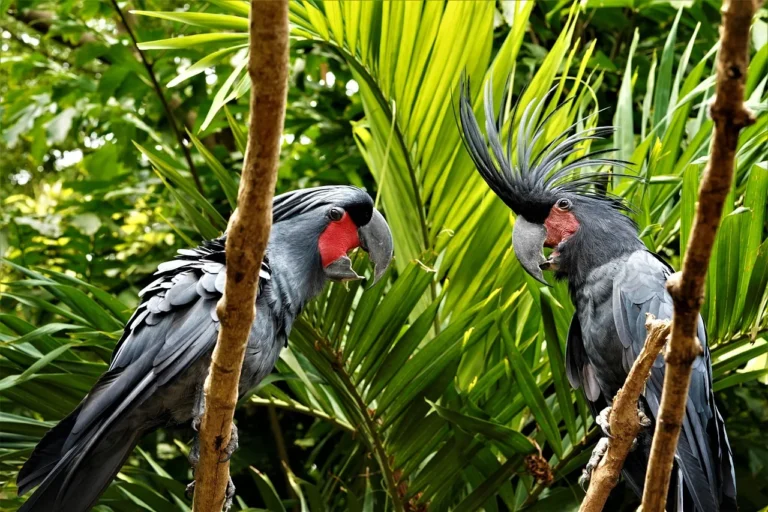Ever seen a bird that looks like it’s dressed up like a rockstar with a mohawk? We’re talking about the beautiful and mysterious black palm cockatoo. It’s one of the most striking parrots the world has ever witnessed. It’s not only attractive but also an intelligent creature. You’ll be surprised to know that these feathered friends can use tools in the wild. For instance, they can actually create and use drumsticks to attract mates.
Jet-black feathers, bright red cheek patches, and massive beaks make their appearance truly unforgettable. Eager to learn more about this amazing bird? Join us as we explore the fascinating world of these rare parrots. You’ll discover their unique behaviors, natural habitats, and why they’re sometimes called the “Goths of the bird world.”
Physical Features and Identification
Scientifically known as Probosciger aterrimus, the black palm cockatoo is among the most exotic birds. The northern tip of Australia, New Guinea, and nearby islands serve as home to these remarkable avians. Here are the distinctive physical features of the black palm cockatoo:
- Deep charcoal or blackish-gray feathers
- Large, powerful beaks (From where they get their scientific name, Probosciger)
- Bright red cheek patches
- A tall, spiky feather crest on top of their head
- Impressive size (They can reach up to 2 feet in length)
- Long, slender tail
- Red tongue with a black tip
Males usually appear slightly larger than females, though telling them apart remains challenging. Their unique behaviors set them apart from other parrots. These black parrots perform drumming displays unlike any other bird species. They also produce distinctive vocalizations ranging from loud whistles and shrieks to drumming on hollow tree limbs. Based on these features, one can easily identify black palm cockatoos.
Behavior and Intelligence
These clever birds really surprise scientists with how smart they are. They’re known for solving tricky problems with ease. Some even show signs of self-awareness, which is rare in animals. Amazingly, they’ve been spotted using tools in the wild. Researchers are still learning more about just how intelligent these birds truly are.
One of their coolest habits is drumming on trees. The male cockatoo picks a stick, trims it to the right size, and drums away. Each bird develops a unique rhythm, kind of like a personal beat or signature. It’s their way of expressing themselves, and maybe showing off a little too.
Cockatoos are also great communicators. They use different sounds for different messages. When danger is close, they make loud, harsh warning calls. If they’re feeling calm and happy, you’ll hear soft, chittering noises. During mating season, they add whistles to their drumming. It’s quite a performance!
These birds are social and loyal to their partners. Most pairs stay together for life, building strong bonds. They also defend their territories together, chasing away any intruders. Depending on how much food is around, their territory can be as large as 100 hectares.
Habitat and Natural Range
Black palm cockatoos prefer tropical rainforests and eucalyptus woodlands. They thrive where tall trees provide nesting hollows. Mangrove forests along coastlines also support small populations. In Australia, they inhabit only the northern cape of Queensland. Their range extends more broadly across New Guinea and nearby islands. They favor lowland forests but occasionally venture into mountainous regions up to 1,500 meters.
These birds adapt to their surroundings by moving seasonally. They follow food availability across their territory. During breeding season, they stay near preferred nesting sites.
Sadly, their habitat faces severe threats from multiple directions, including:
- Deforestation for agriculture
- Mining activities
- Frequent fires in Australia’s north
- Climate change
All of the abovementioned factors pose a danger to their survival.
Diet and Feeding Habits
Wild Palm Cockatoos enjoy a varied diet centered on hard nuts and seeds. They particularly relish pandanus nuts and canarium seeds. These items require their powerful beaks to crack open. Their daily menu also includes native fruits, berries, and small insects. They occasionally eat leaf buds and blossoms during seasonal shortages. Their feeding habits help distribute tree seeds throughout forests.
Their impressive beaks function like natural nutcrackers. You might catch them holding food in one foot while precisely cracking it open. They extract kernels with their dexterous tongues. These birds need regular water access. They typically visit water sources daily, especially during dry seasons. They’ve adapted to collect water from tree hollows during rainy periods.
Feeding occurs mostly in the early morning and late afternoon. They rest during midday heat under canopy cover. This feeding pattern minimizes exposure to predators and harsh sunlight.
Breeding and Life Cycle
The breeding ritual of black palm cockatoos ranks among nature’s most fascinating displays. Males perform elaborate courtship rituals, including stick-drumming performances. These displays may continue for years before females accept them. Nesting preferences center on large, deep tree hollows. Pairs seek trees at least 100 years old with suitable cavities. The same pair may return to a preferred nesting hollow for decades.
Unlike many birds, these cockatoos lay just one egg. The female incubates it for about 30 days. This single-egg strategy represents one of the lowest reproduction rates among parrots. Both parents share chick-raising responsibilities. The young bird grows slowly, remaining in the nest for 100-110 days. Parents continue feeding young birds for several months after fledging. Survival rates for chicks remain alarmingly low. Studies show only 20-35% of eggs produce fledglings. This slow reproduction contributes to their vulnerable conservation status.
Conservation Status
The International Union for Conservation of Nature lists black palm cockatoos as Vulnerable. Population numbers continue declining across their range. Researchers estimate fewer than 3,000 birds remain in Australian territories. Several threats endanger these magnificent birds. Habitat destruction tops the list as mining and agriculture expand. Their extremely low reproduction rate compounds recovery challenges. Illegal pet trade continues despite protective legislation.
Conservation efforts focus on habitat protection and artificial nest boxes. Australian wildlife agencies monitor known populations. Research programs study breeding behavior to improve conservation strategies. You can support these efforts by donating to rainforest conservation groups. Practice ethical birdwatching when visiting their territories. Spread awareness about their plight through social media and conversations with fellow bird enthusiasts.
Can You Keep a Black Palm Cockatoo as a Pet?
The Convention on International Trade in Endangered Species (CITES) strictly regulates these birds. Most countries prohibit importing wild-caught specimens. Captive-bred birds require extensive documentation and permits. Keeping these birds presents enormous challenges even for experienced bird owners. They need massive enclosures for their size and activity level. Their loud vocalizations make them unsuitable for apartment living.
In captivity, they require specialized diets mimicking their natural foods. They need constant mental stimulation through toys and interaction. Without adequate attention, they develop destructive behaviors and feather-plucking habits. Perhaps most importantly, these birds can live up to 90 years in captivity! This lifespan exceeds most owners’ lifetimes. They frequently outlive their caretakers, creating welfare concerns.
Final Thoughts on Black Palm Cockatoo
The black palm cockatoo truly stands among nature’s most remarkable creations. Their intelligence, beauty, and unique behaviors continue to fascinate bird enthusiasts worldwide. Few wild creatures demonstrate such a perfect blend of majesty and personality. As we face growing environmental challenges, protecting these vulnerable birds becomes increasingly important. Their survival depends on preserving the ancient forests they call home. Each lost tree potentially eliminates a nesting site for generations.
Want to read more about our avian friends? Continue visiting our blog.



